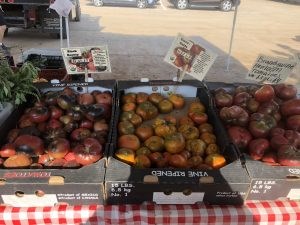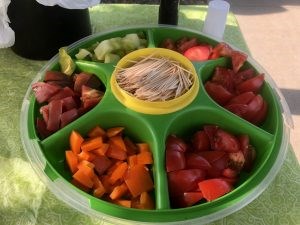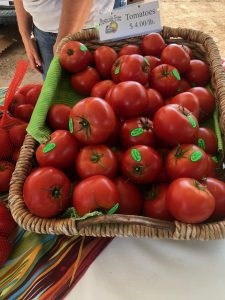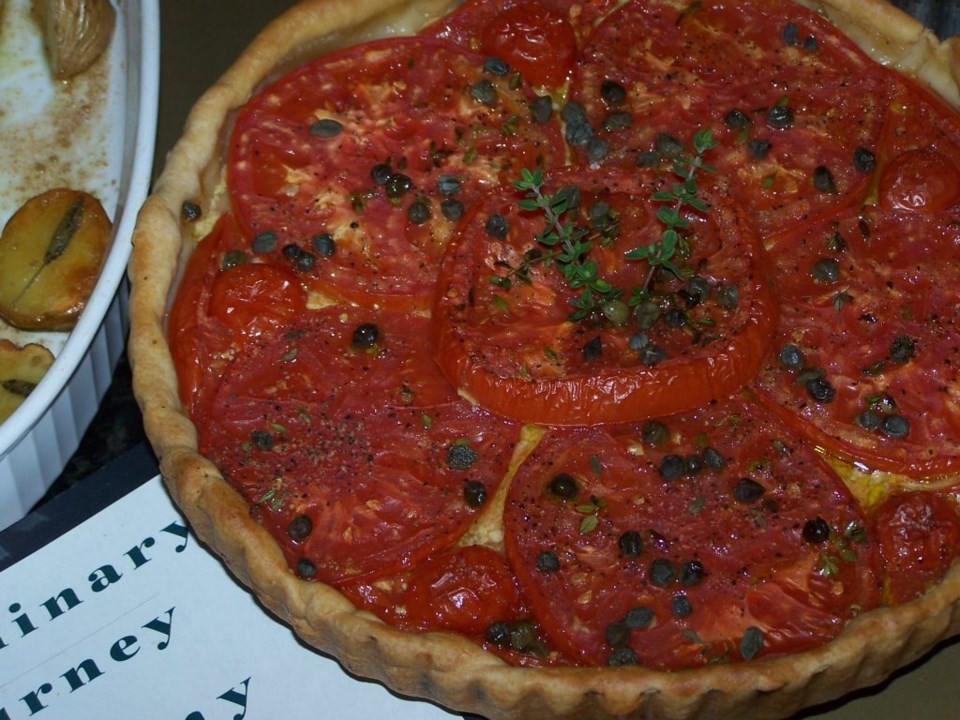This content was originally published by the Longmont Observer and is licensed under a Creative Commons license.
Written by Anne Quinn Corr: Tomato season is in full swing at the Longmont Farmers Market and now is the time to go there with a sturdy basket to ensure that you get your prizes home unbruised. It also helps to take lots of cash, because these popular vegetables command a king’s ransom. No wonder it is the most popular vegetable to grow in the home garden according to the USDA.

Rocky Mountain Fresh, a farm in Lyons, is a market anchor located at the center of the market. Their many tables offer the widest selection—with heirloom varieties like Pink Beauty, Be Orange, Kakao, Cherokee Purple, Brandywine, Striped German, and Cherokee Green. These bad boys are pricey--$6.00 a pound—and one hefty tomato can weigh three-quarters of a pound. But if you are craving the flavor of summer, make the investment and enjoy every bite.
Shirley Marsh, mother of Jason Marsh who owns the Rocky Mountain Fresh enterprise, staffs the stand on Saturdays with other family members and has some tips for protecting your investment. “Never refrigerate tomatoes,” she cautions, adding with a smile, “you can quote me on that.” Store the tomatoes with the stem side down and enjoy when the tomato yields to gentle pressure when you touch it.
 Honeyacre Farm from Wiggins is another vendor that offers a wide variety of tomatoes, heirlooms and the more affordable hybrids. They also offer a sampler plate at the stand so you can choose your favorite. Monroe Organic Farm from Kersey has some unusual heirloom varieties like Black Beauty and Terra Cotta and sells them individually. They are tasty—try a few small ones until you discover your ideal.
Honeyacre Farm from Wiggins is another vendor that offers a wide variety of tomatoes, heirlooms and the more affordable hybrids. They also offer a sampler plate at the stand so you can choose your favorite. Monroe Organic Farm from Kersey has some unusual heirloom varieties like Black Beauty and Terra Cotta and sells them individually. They are tasty—try a few small ones until you discover your ideal.
The line was too long last Saturday at Aspen Moon Farm to even get close to their tables but an email message from the farm recommended going out to the stand in Hygiene (7927 Hygiene Road) where they are running a special deal on heirlooms. The length of the sale will depend on how long the surplus lasts, but mid-week is the best option for reduced prices.
A member of the nightshade family, Solanaceae, the tomato is a tropical perennial that is indigenous to the Andes and was domesticated in Mexico. The Spaniards brought tomatoes to Europe after the Conquest in 1523, and Italians living in Naples, a Spanish possession at the time, were smitten. The Italian love affair with the tomato resulted in a cuisine largely dependent on the luscious marinara sauces that define Italian cooking. However, tomatoes took a long time to reach other European tables. Linked by botanists to poisonous members of the nightshade family like mandrake and belladonna, tomatoes were regarded very suspiciously throughout Europe until the middle of the 19th century. The “love apples,” whose leaves and stems are indeed toxic, were grown in gardens as ornamental plants, not for food.
Consequently, early settlers in America were also suspicious of tomatoes, though Thomas Jefferson grew them in his garden in 1781. According to legend, the tide started to change in 1820 when Col. Robert Gibbon Johnson stood on the steps of the Salem County courthouse in New Jersey before a gathering of his fellow citizens to publicly consume a tomato and challenge the popular negative opinion. He didn’t die or become ill, and the Garden State tomato, which drove a huge industry that included Campbell’s, Heinz and DelMonte during the first half of the 20th century, staked a claim.
Commercial tomato production started around 1900 and increased throughout the first half of the century. Then, in the 1950s and ’60s, Americans’ lust for tomatoes goaded growers into mass-producing them and breeding for superior shipping qualities rather than for taste. We can see the result of those modern production techniques in typical grocery store tomatoes — pale, cottony orbs. Picked unripe and immature, commercial tomatoes are gassed with ethylene to make them turn red. Tomatoes that are left on the vine to ripen produce their own ethylene, a hormone produced by all plants and the natural ripening process occurs slowly, about six days after the first color appears.

More than any other vegetable, the perfect tomato can only be appreciated in season when, with one taste, the flavors dance across the tongue, stimulating the receptors for sweet, salty and sour: epitomizing the meaning of umami, or lusciousness. Don’t miss it this summer.
In our house most tomatoes are enjoyed simply, as sandwiches on white bread (the less intrusion of flavor, the better) with good mayonnaise (good means Hellmann's back east and Best Foods brand here) salt and pepper, nothing else. My husband John is a rebel and likes to add Dijon mustard and my own Mexican bread and butter pickles to his sandwich, but that is gilding the lily in my book. Simplicity is best if the tomato is an heirloom. But if you have an abundance, this simple recipe for a Tomato Tart is an elegant appetizer or lunch dish in these booming tomato times. The recipe is adapted from A Culinary Journey in Gascony by Kate Ratliffe.
Serves 4-6
- Pastry for a 10 inch tart pan
- Dijon mustard
- 3 large ripe tomatoes
- 2 tablespoons olive oil
- 2 tablespoons capers
- Salt and freshly ground pepper to taste
- 1 teaspoon fresh thyme, chopped
Preheat oven to 450°F. Line tart pan with pastry. Brush a thick layer of Dijon on the bottom and sides of the pastry. Place slices of ripe tomato on the bottom of the pan, fitting them in as neatly and tightly as possible. Drizzle with the oil and sprinkle with capers, chopped thyme and salt and pepper. Bake for 20 minutes or more, until the pastry is crisp and golden.



